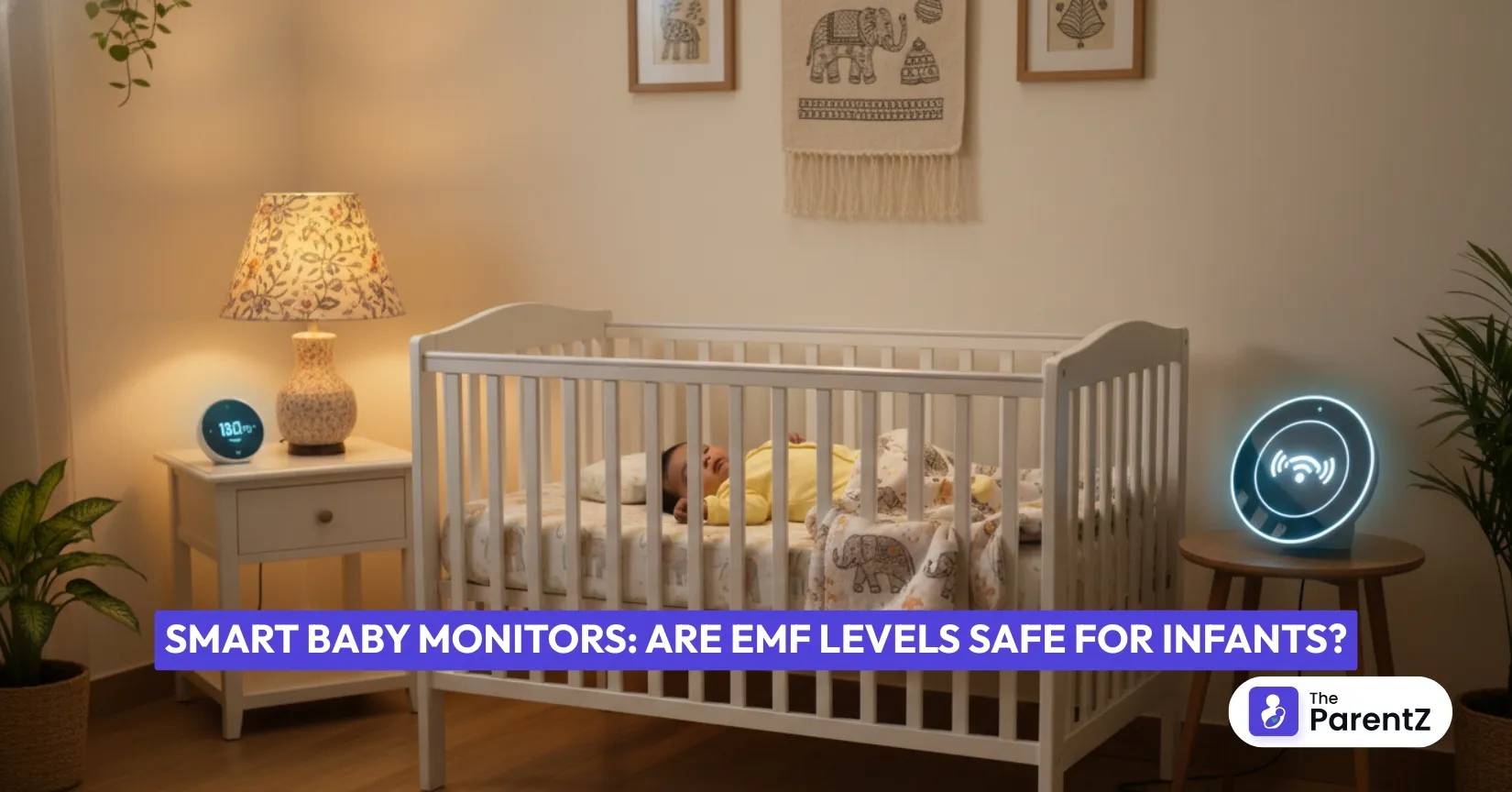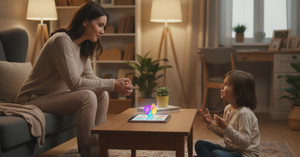You've just installed the brand new smart baby monitor in your child's bedroom, tilted it at the ideal angle, and connected it to your phone. As you gaze at the beautiful, clear video image, however, a persistent question enters your mind: Is this thing releasing radiation close to my baby's crib?
If you've caught yourself Googling "smart baby monitor safety", you're not the only one. Numerous parents are concerned about EMF exposure in babies from wireless devices, and it is a concern deserving of investigation using science-based facts.
Let's explore what research really says about electromagnetic fields from baby monitors, why infants may be more at risk, and most importantly, how you can safely use these useful devices.
What Are EMF and How Do Baby Monitors Emit Them?
Baby monitors, like Wi-Fi and mobile phones, give out small amounts of invisible energy called EMF. This is not the same as strong radiation like X-rays. This is different from ionizing radiation, such as X-rays, which can directly damage DNA.
The amount of RF radiation a monitor emits depends on its type. Old-style audio monitors give out very little radiation. Modern Wi-Fi video monitors give out more, but still much less than a mobile phone during a call.
Here's some reassuring context: baby monitors typically use 10-500 milliwatts of power, while smartphones operate at 250-2,000 milliwatts during calls. Many modern monitors also feature VOX or eco modes that only transmit when they detect sound, dropping emissions to just 1-20 μW/m². This means your baby monitor likely emits significantly less radiation than the phone in your pocket.
Why Are Babies More Vulnerable to EMF?
Before panic sets in, let's understand the biological reasons behind precautionary guidelines for EMF exposure in babies. Children aren't simply small adults—their developing bodies have unique characteristics that make them more susceptible to environmental factors.
Babies’ heads are softer and thinner than adults’, so they can absorb more radiation. Their nervous systems are also developing rapidly, which may make them more vulnerable to environmental factors.
However, it's crucial to frame this information correctly. Greater vulnerability doesn't automatically mean danger—it simply means we should be mindful about placement and usage, which we'll cover in the practical tips section.
What Does Scientific Research Tell Us?
Classification by Health Organizations
Some scientists say EMF could ‘possibly’ cause health problems, but there is no clear proof. In fact, it’s in the same risk group as coffee and pickles—things we use every day
The World Health Organization has thoroughly reviewed the evidence and reports that no harmful health effects have been established regarding the use of mobile phones at levels below international recommendations. The WHO recommends precautions for children due to their still-developing bodies and the gaps that remain in long-term studies.
Recent Sleep Study Findings
A 2024 study tested how baby monitor radiation might affect sleep. Adults were exposed to the same type of radiation that comes from baby monitors for one week. About one in four people had trouble sleeping, similar to insomnia. Brain scans also showed some changes in sleep patterns. This study was short-term and done on adults, not babies, so more research is needed.”
Research on Children's Health
A 2020 study looked at how EMF might affect children. It found that kids who use mobile phones a lot often sleep less well. The study also showed that babies exposed to mobile phones during pregnancy or early childhood were more likely to have some behavior problems as they grew up.”
It's necessary to put these findings into context. Much of the research is looking at mobile phones and Wi-Fi routers, rather than specifically baby monitors. Baby monitors put out much lower levels of radiation and are not usually in use all day like smartphones. One study following over 350,000 children for seven years found no elevation in cancer risk from typical household EMF exposure.
Current Safety Standards
International guidelines established by the International Commission on Non-Ionizing Radiation Protection (ICNIRP) specify a limit of 10 watts per square meter (W/m²) for frequencies above 2 GHz. Baby monitors typically emit just 2.2-7 milliwatts per square meter—well below these safety limits. In a nutshell, experts set safe limits for EMF. Baby monitors give out much less than these limits. However, these safety rules mainly protect against heating effects from radiation, but they don’t fully cover possible long-term effects on growing children
Smart Baby Monitor Safety: Practical Guidelines
Now for the information every parent needs: how to use baby monitors safely without sacrificing the peace of mind they provide.
The 3-Foot Distance Rule
The single most effective step for smart baby monitor safety is maintaining distance. Keep the monitor at least 3 feet (approximately 1 meter) away from your baby's crib. This recommendation works because of the inverse square law of physics—electromagnetic radiation exposure decreases rapidly as distance increases.
Never place monitors inside the crib, through the slats, or directly against the crib's exterior. Position the camera on a dresser, shelf, or wall mount that provides a good viewing angle while maintaining safe distance.
Choosing Safer Monitors
If you’re buying a new baby monitor, look for safer options. Old-style audio monitors give out the least radiation, but they’re harder to find now. For digital monitors, choose ones with VOX or eco mode. These only turn on when the baby makes noise, and stay almost radiation-free when the room is quiet. Consider these smart baby monitor safety features when you are shopping.
Some brands specifically design low-emission technology. The TimeFlys Audio Baby Monitor features a "zero-emission" night mode that produces no RF radiation until sound is detected. When tested with professional equipment placed directly against the unit in eco mode, emissions measured virtually zero.
Consider non-Wi-Fi options over constantly streaming video monitors. While Wi-Fi monitors offer convenience, they maintain continuous data transmission. If you prefer video, choose models that only activate streaming when motion or sound is detected rather than broadcasting 24/7.
Daily Use Best Practices
Turn off the monitor when you're in the same room with your baby. This simple habit eliminates the unnecessary EMF exposure babies receive while providing zero risk to supervision since you're physically present. Avoid the temptation to leave monitors running all day just because they're there.
Use alert-based features instead of constant video streaming when possible. Many smart monitors can send notifications to your phone when they detect crying or movement, eliminating the need for continuous transmission.
Keep in mind that no matter how advanced they are, baby monitors cannot stop SIDS. Cardiorespiratory monitors are not advised by the American Academy of Pediatrics as a means of preventing SIDS.
Physical Safety Considerations
Smart baby monitor safety extends beyond EMF concerns. Follow the advice from the American Academy of Pediatrics: keep all cords at least 3 feet away from your baby's crib to prevent any risk of strangulation. Use cord covers and secure routing to make sure all wires are completely out of your little one's reach.
Update your monitor's firmware regularly if using Wi-Fi-connected models. Outdated software can leave your system open to hackers who might exploit security flaws. To protect yourself, use strong, unique passwords and turn on two-factor authentication whenever possible.
What Indian Parents Need to Know
International safety guidelines apply to baby monitors sold in India, and the devices available in the Indian market emit RF radiation at levels comparable to those sold globally. The key message for parents is balance—modern technology offers genuine benefits for exhausted caregivers monitoring sleeping infants, and simple precautionary measures can significantly reduce EMF exposure babies face.
Safe sleep practices remain the cornerstone of infant safety, more important than any monitoring technology. Smart baby monitor safety is about making informed choices that work for your family while following evidence-based guidelines. There's no need to avoid monitors entirely or feel guilty about using helpful technology—just use it wisely.
Key Takeaways: Quick Safety Checklist
- Position monitors at least 3 feet away from your baby's crib
- Choose analog monitors or digital models with VOX/eco mode when possible
- Turn off the monitor when you're in the same room with your baby
- Never place monitors inside the crib or through crib slats
- Keep all cords secured and at least 3 feet from the crib
- Use alert-based features instead of constant streaming
- Update firmware regularly for Wi-Fi-connected monitors
- Follow safe sleep guidelines—monitors don't prevent SIDS
Final Thoughts
Baby monitors emit radiofrequency radiation at levels far below recognized safety thresholds, according to current scientific evidence. Even though RF radiation is "possibly carcinogenic," this does not imply that baby monitors are harmful when used properly.
Smart baby monitor safety involves both electromagnetic awareness and physical safety considerations like cord placement and cybersecurity. With simple precautionary measures—especially maintaining proper distance—parents can minimize EMF exposure in babies receive without sacrificing the valuable monitoring these devices provide.
The goal isn't to create anxiety but to empower informed decision-making. You can confidently use baby monitor technology while prioritizing your infant's safety and maintaining your peace of mind.
Download The ParentZ app today and get access to easy-to-use baby health tracking tools that make your life simpler.
Visit TheParentZ.com to find expert-backed advice, helpful articles on child health and safety.
References
- https://birminghamcontrolcentre.co.uk/is-radiation-from-a-baby-monitor-safe-separating-facts-from-fears
- https://emfacademy.com/best-low-emf-baby-monitors/
- https://pmc.ncbi.nlm.nih.gov/articles/PMC7642138/
- https://bebcare.com/blogs/news/understanding-emf-and-why-it-matters-for-your-baby-s-health
- https://pmc.ncbi.nlm.nih.gov/articles/PMC7642138/








Be the first one to comment on this story.